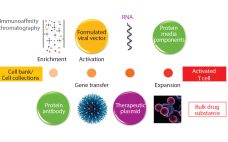After many years of development, gene therapy is beginning to deliver on its promises in the clinic, in some cases with spectacular outputs. Those clinical successes also have led to an influx of funding and engagement from large pharmaceutical companies, thereby bringing the required financial support and expertise for late-stage clinical developments and product commercialization. Although many initial studies were confined to small patient groups and focused on a range of rare monogenetic diseases, new approaches to gene editing have…
Author Archives: Tony Hitchcock
Manufacturing Plasmid DNA: Ensuring Adequate Supplies for Gene and Cell Therapies
The concept of gene therapy is far from new, with initial studies performed over 20 years ago (1). However, in the past few years an explosion of interest in this area has gone beyond initial regenerative approaches using viral vectors. Interest is now moving increasingly into potential use of T cells modified using recombinant viral vectors for immunotherapy applications. Such therapies are based on using either adenoassociated virus (AAV) or lentivirus (1), both vectors being frequently generated through transient expression…
Clinical/Commercial Manufacturing: BPI Theater @ BIO 2015
Tony Hitchcock (technical director, Cobra Biologics) 1:30–1:55 pm The Expanding DNA and Gene Therapy Market The gene therapy market has fluctuated dramatically over the past 20 years. But Hitchcock noted that over the past three years there has been a huge emergence of successful clinical outputs of gene therapy, with a large number of IPOs and significant funding. Even more interesting is the number of large pharmaceutical companies bringing gene therapy into their portfolios. Hitchcock pointed out that it is…
The Expanding DNA and Gene Therapy Market (Video)
Production of Recombinant Whole-Cell Vaccines with Disposable Manufacturing Systems
Live whole-cell bacterial products have been used as vaccines for many years, and there are currently three such products licensed on the market. Over recent years, however, interest has renewed in this type of product as a delivery system for novel recombinant therapies and vaccines. A number of different organisms have been proposed, such as Escherichia coli and Salmonella species, which might have applicability for such applications. Vaccine applications tend to relate to the potential for low-cost orally delivered products…



